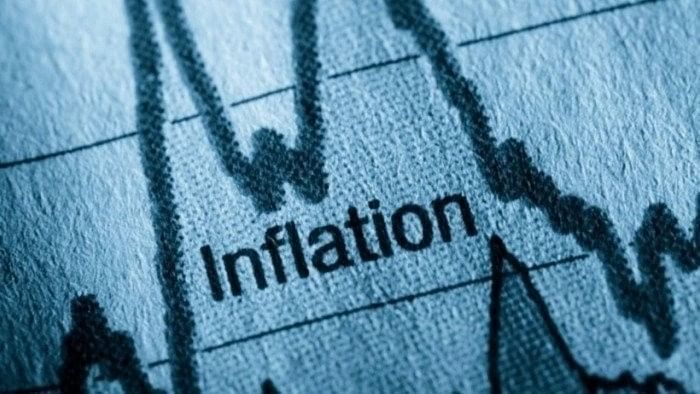
Representative image showing an illustration of inflation graph.
Credit: iStock Photo
Inflation is consumers’ misery as they must shell out more for the same goods and services. Labour households in India’s vastly informal economy account for more than 90% population. Inflation hurts them the most.
For economists and central bankers, inflation means an increase in the price of a product compared to its price last year. For the people, it is a
different living reality. For them, inflation every year piles on the inflation of the previous years, compounding their misery. As they spend most of their incomes on food, food inflation matters to them the most.
The Reserve Bank of India (RBI) governor can draw solace from a 5.09% CPI inflation (when food inflation is still at 8.38%) and characterise the same as retreat of inflation elephant to forest. For people, who have faced a cumulative 40% plus food inflation in the last five years, the elephant is continuing its rampage.
What is going on on the inflation front? Is there a big disconnect between
the government/ RBI and people in terms of consumer price inflation?
Composite CPI, which measures consumer inflation for both urban and rural households and for food and non-food, had a reading of 139.6 in January 2019. The composite CPI increased to 185.5 in January 2024. In five years, consumer inflation increased by 32.88% — that’s by 6.58% every year.
Indian consumers are paying almost a third more in 2024 for the same basket of goods and services than they were paying in 2019.
Consumer Food Price Index (CFPI), a part of CPI with about 45% weight, increased from 135.1 in January 2019 to 189.3 in January 2024. Food prices recorded an increase of 40.12% in five years which is above 8% per annum. Even if you were to compound, food inflation has been as high as 6.99% for five years, which is much higher than the maximum limit of 6% prescribed by the government. It must have been a back-breaking experience for India’s poor and inflation-unprotected labour households.
Within the food basket, vegetable prices were 48.97% higher in January 2024 than in January 2019 (index value 135.2 and 195.6 respectively), despite having come off substantially from 250.2 in July 2023. Pulses prices rose by 69.83% during this period — an annual price increase of about 14%. Spices recorded the worst price increase of 73.82% in five years.
Sugar and confectionaries witnessed the lowest inflation of 19.25%, followed by
milk and milk products (28.57%), oil and fats (30.71%) and fruits (26.96%). For these low-inflation categories, annual price increases ranged from 4% to 6.5%.
Besides suffering, the consumers held back their consumption, which is reflected in low consumption growth in GDP as well.
The RBI makes a big show of adjusting its interest rate setting repo rate every two months to keep the CPI inflation within 4% plus/minus 2% mark. The truth is that, the RBI policy rate has no impact on CPI inflation.
Agriculture credit has consistently risen, irrespective of whatever repo rate the RBI decided, as farm credit follows a very different dynamic. Its secular growth is from ever-increasing farm credit entitlement linked to the cost of cultivation with most of the interest on agriculture credit borne by the governments.
The demand for the CPI basket, mostly the essential consumption goods, has
no connection either with the credit supply. The supply of commodities and services in the CPI basket depends on
the weather, government policy action, and global geopolitics over which the RBI has
no influence.
Failed govt measures
The government provided free cereals to more than 800 million Indians and subsidised fertilisers by 80-90% spending Rs 22.27 trillion on these subsidies during the last five years. This is almost 60% of the total output value of Rs 35 trillion of all cereals crops.
The government banned the export of wheat and some varieties of rice, and put restrictions on exports of other rice varieties. The government disallowed diversion of wheat and rice for ethanol production. Still cereals inflation recorded an annual inflation rate of more than 5.5% per annum.
The government placed restrictions on onion export and later banned it completely. Many other measures, like putting stock limits for traders, etc. were also taken. Nothing really worked.
India is a surplus foodgrains producer and a significant net exporter of agriculture commodities. Still there is deeply entrenched and sticky consumer inflation, which gets worse seasonally. The current policies and programmes are certainly not working.
De-governmentalising India’s agriculture, bringing structural land reforms, introducing markets in agriculture, shifting more than 75% of the population dependent on agriculture to non-farm jobs, and converting all input and MSP subsidies into a direct cash transfer to farmers is the only reform package
that can make a real difference to farmers’ lives and consumer inflation.
(The writer is former Finance & Economic Affairs Secretary, and author of ‘The Ten Trillion Dream’ and ‘We Also Make Policy’)